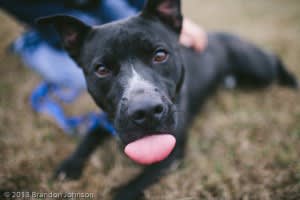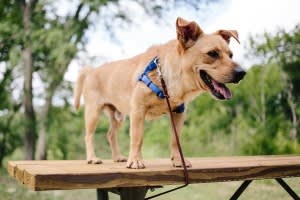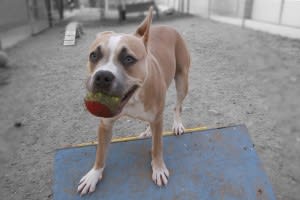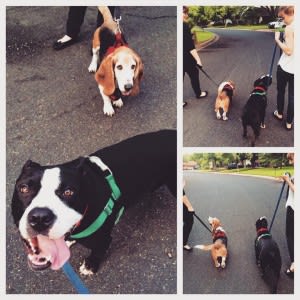Shelter Behavior Workshop, Level 2
Dogs Out Loud
August 2016
Shelter Behavior Manual – Level 2

https://www.dogsoutloud.org/training-handouts/shelter-behavior-manual-level-2/
Purpose
The purpose of this training is to build on the basic skills we introduced in Level 1 and to give handlers the knowledge they need to help dogs with resource-intensive behavior issues.
OBJECTIVES
- To learn clear and consistent techniques for training our dogs, ensuring that staff and volunteers are trained in the same methods and approaches and veterans are able to help reinforce those methods for new volunteers & staff.
- To use small changes to create big results. Knowing what to do at just the right moment can be the difference between having a successful session with a dog or having a lousy time.
- To provide clear and actionable information that enables staff and volunteers to safely and comfortably manage, support and adopt out dogs with varying behavioral needs.
Dog Body Language
What is the dog saying to you and how are you using that information to redirect unwanted behavior?

- Promote Appropriate Behavior
- Redirect Unwanted Behavior
- Reinforce Calming Signals
- Recognize Eye Contact
Understanding Stress
How Stress Affects Shelter Dogs
Watch Stress Recognition and Reduction in Shelter Dogs
Kelley Bollen, MS, CABC and Behavioral Consultant for the Maddie's® Shelter Medicine Program
Recognizing Signs of Stress
Stress Responses:
"Calming" or "Cut-Off" Signals
"We need to learn to understand the language of dogs so that we can understand what our dogs are telling us. That is the secret of having a good life together."
(Turid Rugaas - Calming Signals - The Art of Survival)
- dilated pupils
- rapid blinking
- elongated eyes
- closed mouth
- or opens/closes
- puffy flews (upper lips)
- ears back
- muscle tension
- tail lowered/tucked (covering the scent glands; I'm not here!)
- body lowered
- paw raised (appeasement gesture)
- body leaning away
- head/body turned away
- lip licking (usually repetitive)
- yawning
- shut down/frozen
- restlessness/ hyperactivity, pacing
- vigilantly scan environment
- piloerection
- shallow breathing/panting
- shaking off
- scratching, sniffing, stretching, or doing something that seems out of the norm for the situation
- approach-avoidance behavior (dog may appear to be friendly one minute and then fearful or even defensive the next)
- Decreased, thick, or profuse salivation
- Perspiring paw pads
- Blowing/shedding fur, dandruff
- Loss of appetite (food/water)
- Or perhaps an increase in water!
- Diarrhea
- Excessive grooming
Clear Boundaries Reduces Stress
Catch the behaviors early in their onset

- Be willing to set expectations: Kennel Routine; loose leash walking; eye contact, and; redirect unwanted behavior quickly and calmly.
- Model the behavior you want. You can escalate the behavior if you get excited.
- Consistency is key. Dogs can't generalize what they've learned if everyone does things differently.
- Be present and speak their language.
Safety
Table standing is only for special occasions.

- Use the right equipment (refresh audience knowledge as needed)
- In order to complete Level 2 training, all attendees must demonstrate the ability to put a harness on a real dog
- Be Prepared
- Um, he doesn't want me to leave …
- Dog Fight
- Loose Dog
Behavior Modification
Naughty dogs need love too.

- Jumping
- Mouthing
- Leash biting
- Reactivity
- Shy/Fearful/Shut Down
- Barrier Frustration
- Disengaged/Aloof (Premack)
Tools
When working with this population of dogs, treats cannot be the only tool in our toolbox!

- A variety of treats
- Premack Principle (you can use a high probability behavior to reinforce a low probability behavior)
- Safety Equipment
- Toys …
… Toys are Tools!

Especially with this subset of shelter dogs, toys are not a frivolity or just something to leave a dog alone with. Play training and play time are as important for shelter dogs as potty breaks.
Toys are handy for:
- Redirecting mouthy dogs
- Distracting shy or reactive dogs
- Building a relationship
- Changing a moment
- Rewarding a success
- Salvaging a failure
- Teaching important skills
- Easing stress
"Toy play is considered a "luxury behavior". So the idea is that if an animal is suffering, has poor welfare, he is not going to be likely to play. So providing animals opportunities to play gives you a good guage on how they are feeling."
(Dr. Pam Reid - Enrichment programs to promote behavioural wellbeing in shelter)
The goal is to bring the dog's stress level down to the point that his physiological and safety needs are met. After that, his willingness to play will often emerge.
Toys are Enrichment!
Toys provide Active Enrichment - all dogs need access to a rotating variety of enrichment items. Dogs need toys to chew on as well as toys to play with. Also rotate through consumable chewies (bully sticks, jerky sticks, etc.).
Team Players Wanted!

- Be willing to set clear and consistent expectations/boundaries:
- Follow Kennel Routine: calm/four paws on the floor/sit AND eye contact to leave the kennel;
- Practice loose leash walking everywhere;
- Know how to redirect a mouthy dog to carry a toy, play find it or Go Hunt, or hand target; and,
- Engage with the dog constantly throughout your session.
- Use appropriate equipment
- Understand dog body language and these behaviors so you know how to redirect and teach an appropriate replacement behavior
- Understand your own limits and work only with the dogs you know you can handle
Helping a Young or Rowdy Dog Put His Best Paw Forward
Send those doggies home!

- These behaviors are likely specific to the shelter, and may not be as intense or even present in a home.
- Be careful what you say about dogs – "He needs to be a working dog." "He needs to go a distance runner." "He needs to live with a trainer." – because it might not come true in a home!
- Don't oversell the energy level.
- Set reasonable expectations for who can succeed with this dog.
THE END
Dogs Out Loud | www.dogsoutloud.org
Created using Reveal.js